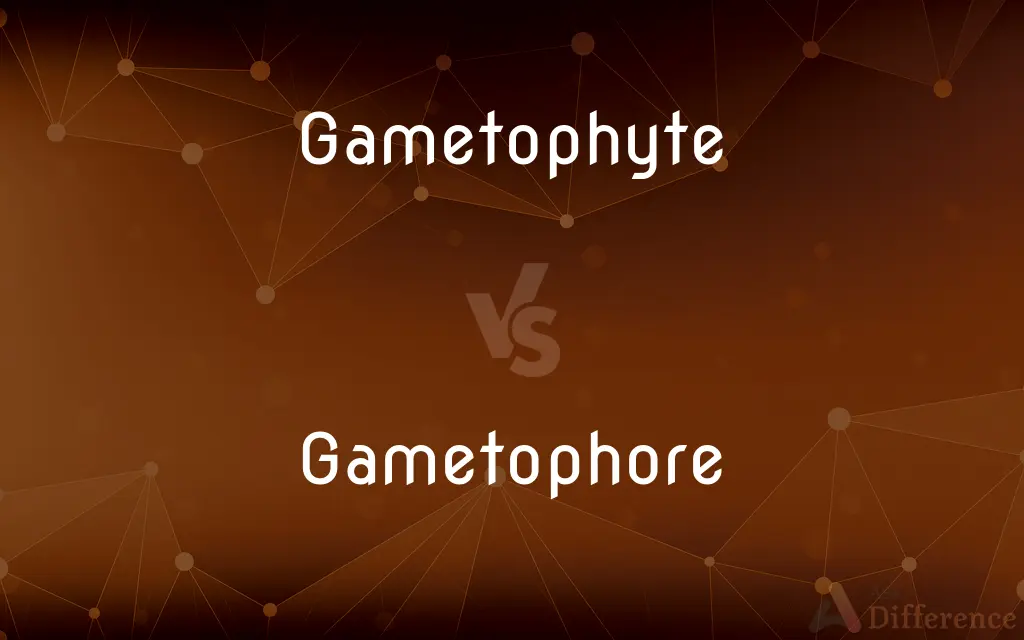Gametophyte vs. Gametophore — What's the Difference?
By Maham Liaqat & Fiza Rafique — Updated on April 26, 2024
Gametophyte is the sexual phase in the life cycle of plants and algae, which produces gametes, while gametophore is a structure that bears the gametes on the gametophyte.

Difference Between Gametophyte and Gametophore
Table of Contents
ADVERTISEMENT
Key Differences
A gametophyte is a stage in the life cycle of plants and algae that is haploid, meaning it has a single set of chromosomes and produces gametes (sperm and eggs) through mitosis. In contrast, a gametophore is not a stage in the life cycle but a specialized part of the gametophyte itself, which carries the sex organs—archegonia (female) and antheridia (male).
In mosses and liverworts, the gametophyte is the dominant, photosynthetic, and long-lived part of the life cycle, visible to the naked eye as green, leafy tissue. Meanwhile, the gametophore arises from the gametophyte as a smaller, often stalk-like structure that specifically holds the reproductive organs.
Gametophytes can be either monoicous, where a single individual produces both male and female gametes, or dioicous, with separate male and female individuals. On the other hand, gametophores reflect this differentiation by varying in structure and function depending on whether they carry antheridia or archegonia.
The development of gametophytes involves a broader range of growth and environmental interactions, as they can form various structures like rhizoids, leaves, and stems depending on the species. Conversely, gametophores are more limited in function and diversity, focusing solely on reproduction.
Gametophytes play a crucial role in the sexual reproduction of non-vascular and seedless vascular plants by facilitating genetic diversity through the fusion of gametes. In contrast, gametophores are essential for the precise positioning and protection of gametes, ensuring effective fertilization and subsequent sporophyte development.
ADVERTISEMENT
Comparison Chart
Definition
Haploid life cycle stage producing gametes.
Structure on gametophyte bearing sex organs.
Function
Produces gametes, supports photosynthesis.
Carries and positions reproductive organs.
Presence
Found in all land plants.
Mostly in bryophytes like mosses and liverworts.
Longevity
Can be long-lived and visually dominant.
Temporary, dependent on reproductive cycle.
Structural Diversity
Includes roots, stems, or leaves in some species.
Typically limited to stalks or branches bearing antheridia or archegonia.
Compare with Definitions
Gametophyte
The plant form that gives rise to eggs and sperm.
The gametophyte of flowering plants is highly reduced and found within the flower.
Gametophore
A specialized part of a gametophyte bearing reproductive organs.
In moss, the gametophore extends upwards from the leafy gametophyte.
Gametophyte
The stage following spore germination in a plant's life cycle.
Fern gametophytes develop from spores into small, heart-shaped structures.
Gametophore
Appears during the reproductive phase of gametophytes.
Gametophores develop when moss gametophytes reach maturity.
Gametophyte
Independent and photosynthetic in non-vascular plants.
Liverwort gametophytes form mats that cover moist ground.
Gametophore
Essential for the reproductive success of bryophytes.
Without gametophores, the spatial separation of gametes in moss would be challenging.
Gametophyte
A haploid organism in the life cycle of plants producing gametes.
In mosses, the green leafy structure we see is predominantly the gametophyte.
Gametophore
Varies structurally between carrying male or female organs.
Male gametophores bear antheridia at their tips.
Gametophyte
A crucial phase in the plant life cycle for genetic variation.
Each gametophyte carries unique genetic information, vital for biodiversity.
Gametophore
The structure responsible for holding and protecting gametes.
Moss gametophores ensure gametes are ideally positioned for wind or water fertilization.
Gametophyte
A gametophyte () is one of the two alternating multicellular phases in the life cycles of plants and algae. It is a haploid multicellular organism that develops from a haploid spore that has one set of chromosomes.
Gametophore
The word gametophore, also known as gametangiophore, is composed of gametangium and "phore" (Greek Φορά, "to be carried"). In moss and fern (Archegoniata) the gametophore is the bearer of the sex organs (gametangia), the female archegonia and the male antheridia.
Gametophyte
The haploid gamete-producing phase in a plant characterized by alternation of generations.
Gametophore
A structure, as in liverworts and mosses, on which gametangia are borne.
Gametophyte
(botany) A plant (or the haploid phase in its life cycle) which produces gametes by mitosis in order to produce a zygote.
Gametophore
(botany) in ferns, the bearer of sex organs
Gametophyte
In the alternation of generations in plants, that generation or phase which bears sex organs and produces gametes. In the lower plants, as the algæ, the gametophyte is the conspicuous part of the plant body; in mosses it is the so-called moss plant; in ferns it is reduced to a small, early perishing body; and in seed plants it is usually microscopic or rudimentary.
Gametophore
A modified branch bearing gametangia as in the thalloid liverworts.
Gametophyte
The gamete-producing individual or phase in the life cycle of a plant having alternation of generations
Gametophore
A modified branch bearing gametangia as in the thalloid liverworts
Common Curiosities
Are gametophytes visible to the naked eye?
Yes, in many plants like mosses and ferns, gametophytes are visible and often the dominant visual form.
How does a gametophore function?
A gametophore functions as a structure on a gametophyte, specifically designed to bear and protect reproductive organs.
What types of plants have gametophores?
Gametophores are typically found in non-vascular plants such as mosses and liverworts.
What distinguishes a gametophyte from a sporophyte?
Gametophytes are haploid and produce gametes, whereas sporophytes are diploid and produce spores.
Can gametophores perform photosynthesis?
While primarily reproductive, some gametophores may carry out photosynthesis if they have chlorophyllous tissues.
How long do gametophores last?
Gametophores last only as long as the reproductive season and usually wither after fertilization has occurred.
What is the typical size of a gametophore?
Gametophores are generally small, often just a few centimeters tall, designed to elevate the reproductive organs.
What is a gametophyte?
A gametophyte is a haploid plant stage that produces gametes for sexual reproduction.
How do gametophytes contribute to plant diversity?
Gametophytes allow for the combination of genetic material from different individuals, increasing diversity.
Do gametophytes need gametophores to reproduce?
In plants where gametophores are present, such as mosses, they are essential for effective sexual reproduction.
How do environmental factors affect gametophyte development?
Environmental factors like moisture, light, and temperature significantly influence gametophyte growth and development.
Is a gametophore the same as a flower?
No, a gametophore is not a flower; it is a simpler structure bearing sex organs in certain non-flowering plants.
Are gametophores found in all plants?
No, gametophores are specific to certain groups of plants, mainly bryophytes.
Can gametophytes self-fertilize?
Monoicous gametophytes can potentially self-fertilize since they produce both male and female gametes.
Do gametophytes have roots, stems, and leaves?
Some gametophytes, especially in mosses and liverworts, have structures analogous to roots, stems, and leaves, but these are often simpler than those of higher plants.
Share Your Discovery

Previous Comparison
Pulpit vs. Altar
Next Comparison
Apace vs. PaceAuthor Spotlight
Written by
Maham LiaqatCo-written by
Fiza RafiqueFiza Rafique is a skilled content writer at AskDifference.com, where she meticulously refines and enhances written pieces. Drawing from her vast editorial expertise, Fiza ensures clarity, accuracy, and precision in every article. Passionate about language, she continually seeks to elevate the quality of content for readers worldwide.














































